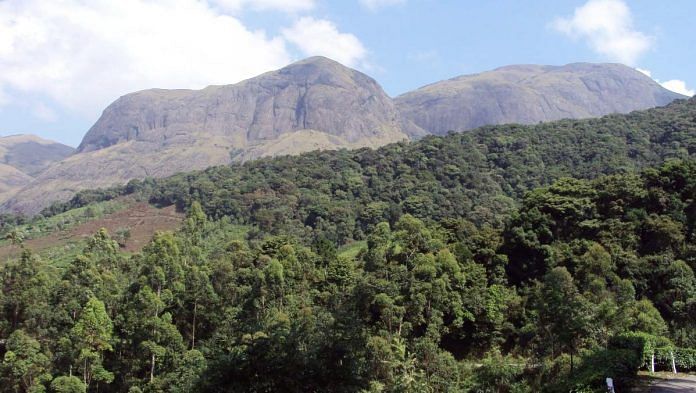Bengaluru: A first-of-its-kind study, assessing the effectiveness of forest restoration in the Western Ghats, shows significant recovery of tree cover and plant biodiversity.
Controlled active restoration, performed by planting native species and eliminating weeds, can also aid carbon sequestration, the study has found.
Scientists from Nature Conservation Foundation, India and Columbia University, USA jointly conducted the study, which was published in the journal Ecosphere last week. The study was based on restoration projects that have been under way for over 20 years in Anamalai Hills, a biodiversity hotspot in India’s Western Ghats.
Also read: Why the new UN report on climate change is alarming for India’s fishing ecosystem & oceans
Ecological restoration — past and present
Ecological restoration is a primary strategy for countering biodiversity losses and deforestation. Only a few studies on the subject have been done, especially those comparing active restoration by human intervention to natural restoration.
The researchers conducted their study on the Valparai Plateau, a 22,000-hectare section of the Anamalai Hills, which they describe as a “human-modified landscape”.
The region has witnessed extensive deforestation between 1890 and 1940 for tea, coffee, cardamom, and eucalyptus plantation by the British. Remnants of the rainforest were used for selective timber felling in the past.
Since 2000, three plantation companies have conducted restoration activities on the plateau.The sites were carefully chosen after ensuring they were degraded rainforests alone and didn’t include the famously misunderstood native grasslands of the Western Ghats.
“All too often, rare, threatened, and ecologically irreplaceable ecosystems such as grasslands are destroyed by misguided attempts at ‘restoring’ forests in areas where forests have not been known to occur naturally over recent ecological history,” lead author Anand Osuri, ecologist with Nature Conservation Foundation, explained to ThePrint.
Also read: Study traces how the British ruined Western Ghats, one of India’s most unique ecosystems
The restoration process
The active restoration process included steps to prevent cutting of wood, preventing the growth of weeds, and planting a diverse variety of native species.
“The selection of tree species for planting at each location was based on careful consideration of local environmental conditions such as elevation, topography, and the presence of streams,” stressed Osuri.
“In general, a thorough understanding of the different kinds of natural ecosystems that could potentially occur in an area is essential before any attempts are made to restore degraded habitats,” he added.
Researchers studied an average of 1,099 plants, spanning 106 species, per hectare.
They also studied 50 plots of land in the region, half of which underwent ‘active restoration’, while the other half underwent ‘natural regeneration’ where nature took over with no human intervention. Before and after photographs helped compare tree cover, and the sites were studied in pairs.
Eleven indicators were compared by them, including factors like canopy cover percentage, adult and sapling tree density, trees’ measurements and ratios, percentage of native vs. non-native species, and carbon storage.
According to Osuri, “A key strength and distinguishing feature of our study is that we examined multiple components of ecosystem recovery, from canopy closure and the diversity of tree species, to the amount of carbon sequestered, in restored forests.”
“Ours is also among the few studies that empirically test how recovery of these properties varies across fragmented forests of a human-dominated landscape. This is the first study of its kind in the Western Ghats, and possibly in all of India,” he added.
Findings and future
The 25 pairs of plots were compared with 17 ‘benchmark’ regions that were free of human activity.
The team discovered that active restoration came closer to the natural ecosystem and healthy growth of the benchmark areas. Compared to natural regeneration, these plots also showed more consistent and prominent results.
Actively restored regions saw an increase of 82% in canopy cover, 69% in adult tree density, and 49% in species density. Other factors like sapling density and carbon storage also increased.
The Earth has a limited quantity of carbon, and thus any form of long term storage of carbon — called carbon sequestration — is beneficial. Biosequestration, or storing of carbon through biological processes such as growing of trees, is a popular and cost-effective method of carbon capture. Other methods include storage through peat or biochar.
The difference was noticeable in 7 to 15 years of restoration.
Also read: Biochar could be the solution to crop burning that Indian farmers were waiting for
“The Nature Conservation Foundation has been attempting to ecologically restore degraded rainforests in the Anamalai Hills for much of the past 20 years,” said Osuri, “The present study was an attempt to critically evaluate the effectiveness (or lack thereof) of the restoration interventions.”
The details obtained from this study, in terms of the various parameters measured, could act as a baseline for future recovery efforts and how they are measured.
“The failures identified highlight priorities for future research. For example, as a next step, we would like to understand why invasive species are able to outcompete native species in the understory of restored forests, and what steps could be taken to increase regeneration by native species,” Osuri added.
As afforestation continues to be adopted as a popular global heating mitigation tool, the study points to the relevance and importance of active reforestation instead. Reforestation essentially is ecological restoration done by planting native species in areas that previously contained forests and keeping in mind the importance of removal of weeds.
The increased forest cover, growth of biodiversity, as well as high carbon storage could all act to combat increasing temperatures and unsustainable human activity in the world.



